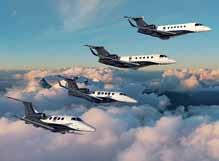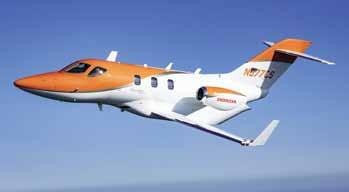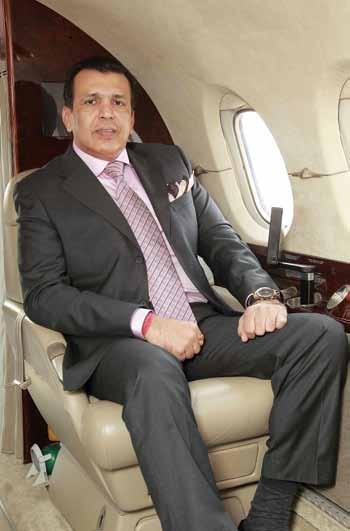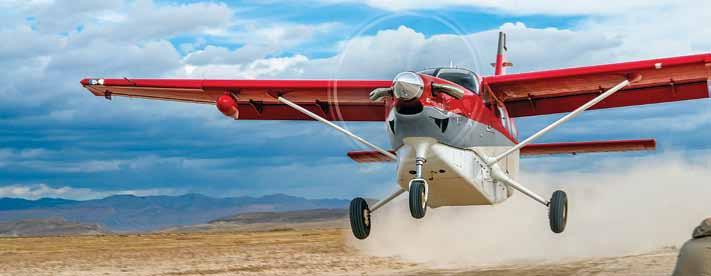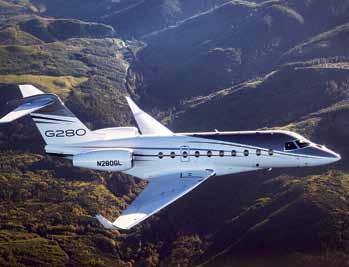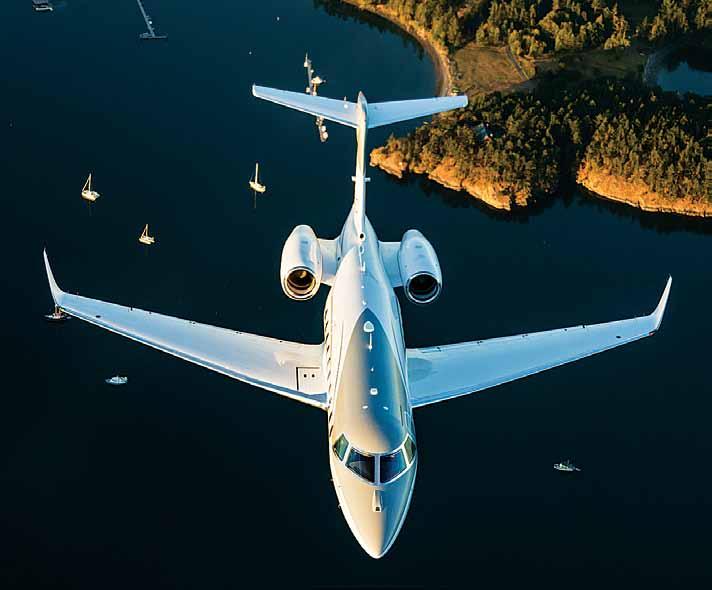
18 minute read
NeWS aT a gLaNCe
ties through a third-party provider chosen by Gulfstream. One car- SuStaiNaBiLitY BY DeSiGN bon offset represents the reduction of 1 metric tonne/2,205 pounds of Gulfstream’s innovative, clean wing designs deliver a combination of greenhouse gas emissions, the company added. record-breaking speed and range, exceptional comfort, and better aero-
Gulfstream had also announced that the Gulfstream G650ER, dynamic efficiency for a smaller carbon footprint. The wings of the Gulfstream G600, Gulfstream G500, Gulfstream G550 and Gulf- Gulfstream G500, G600, G650, G650ER and G700 are manufactured stream G280 made the company’s first carbon-neutral flights, travel- on-site, decreasing transportation emissions and packaging waste. ing from Savannah to the Las Vegas area for the 2019 National Business Aviation Association Convention & Exhibition (NBAA-BACE). POWeRiNG cONSeRVatiON The five flights were made using a combination of sustainable avia- State-of-the-art engines across Gulfstream’s fleet decrease fuel usage, tion fuel (SAF) and carbon offsets. produce fewer greenhouse gases, and are central to the company’s
Advertisement
The renewable fuel used by Gulfstream is produced by World unparalleled achievements in engine noise reduction, which means Energy at its refinery in Paramount, California, from a feedstock minimised disruption to communities and ecosystems worldwide. of agricultural waste, fats and oils. Fuel and aviation services provider World Fuel Services manages the logistics, including LeaDiNG the iNDuStRY distribution of SAF to Gulfstream on both US coasts. In addition Gulfstream’s Enhanced Flight Vision System (EFVS) allows authoto using the 30/70 blend of low-carbon, drop-in SAF at its Savan- rised pilots to land in low-visibility conditions, increasing efficiency nah headquarters, Gulfstream makes it available for customers at by reducing go-arounds and saving fuel and time. In 2018, Gulfits Van Nuys and Long Beach, California, service centers. SAF is stream had become the world’s first aerospace company to certify the only fuel on-site at Gulfstream Long EFVS for touchdown and rollout. Beach, which also uses it for completions and delivery flights. DRiVeN BY R&D
“The innovative partnership between Across the 6,26,743 square feet of research Gulfstream and World Energy paved the and development facilities that Gulfway for a larger sustainability movement,” Burns said. “For almost a decade, we have Last year, stream has, the manufacturer provides the industry’s leading talent with the space, leveraged our collaboration with World GuLfstream opened tools and state-of-the-art technology to Energy to increase awareness and availability of SAF around the world. We look a service center innovate for future flight. This steadfast investment in the company’s labs—for forward to continuing that work.” in farnborouGh, development, training and human factors In December 2019, Gulfstream had announced that its Savannah-based fleet has flown more than 1.85 million kilomedesiGned with environmentaL testing—reduces in-air flight-test hours, thus reducing carbon emissions. ters on SAF. Gulfstream highlights that it uses a blend of 30 per cent low-carbon, drop-in fuel derived from agricultural benefits, incLudinG rainwater harvestinG, GReeN FaciLitieS Gulfstream, ensures that it is building for the future. At the company’s Savanwaste and 70 per cent traditional Jet A. radiant heatinG nah headquarters, multiple facilities have SAF provides the same performance as conventional, petroleum-based jet fuel systems in the LEED (Leadership in Energy and Environmental Design) certifications for design, and requires no changes to factory-stan- purpose-buiLt hanGar, materials and technologies that drastically dard engines or aircraft. Every gallon used by Gulfstream’s Savannah-based fleet saves at least 60 per cent in carbon inteLLiGent LiGhtinG controLs and heat reduce water and energy usage. FueLiNG PROGReSS dioxide emissions on a life-cycle basis vs. petroleum-based jet fuel, claims the recovery systems Gulfstream believes that the future of business travel is powered by SAF. Throughout manufacturer. its lifecycle, SAF achieves at least 60 per
Gulfstream has announced a new ser- cent reduction in carbon dioxide emissions vice that reinforces the company’s com- per gallon, compared to petroleum-based mitment to sustainability and provides Gulfstream operators with jet fuel. Since 2016, Gulfstream has used this cleaner alternative the opportunity to reduce the carbon footprint associated with in daily operations including the Gulfstream G700 flight-test protheir flights. gramme. In 2019, the company became the first business jet manu-
There are several elements to Gulfstream’s sustainability pro- facturer to make SAF available to customers. gramme, including aircraft sustainability, eco-friendly buildings and the use of SAF for its corporate, demonstration, Customer Support caRBON NeutRaL tRaVeL and Flight Test fleets in Savannah. In addition, Gulfstream’s Long Gulfstream underlines its pride in raising the bar for eco-conBeach, California, maintenance and completions facility sells SAF to scious business travel, and invites its customers to take part in customers and uses it for completions and delivery flights. The first that achievement, an example of which is the carbon offset probusiness jets certified for stage 5 community noise levels are those of gramme, which is available through Gulfstream’s Aircraft OwnerGulfstream. Some of the aspects of Gulfstream’s sustainability pro- ship Service and funds activities that generate an equal reduction gramme include: in carbon emissions. BAI
Best Structured Practices for Acquiring a Business Aircraft
By Sudhir S. rajeShirke
Start with understanding the client’s travel requirements – both current and future and then shortlist aircraft based on this preliminary analysis. Follow it up with educating the client on what best options are suitable for their travel needs.
Harvard Business school professor Ted Levitt said "People don't want to buy a quarter-inch drill. They want a quarter-inch hole!" Customers, mainly business leaders, politicians and entrepreneurs, who need to save travel time, require privacy when traveling and need to get work done while onboard an aircraft, have various options of fulfilling their on-demand travel needs – charters, block hour programmes and finally aircraft acquisition. The solution has to start with understanding the key purpose and the nature of the client’s travel needs. In few cases, acquiring an aircraft is just the right solution.
But first, we need to clarify that when customers purchase an aircraft, they should do so primarily for their own use, not to make profit out of external charter, because most likely, they won’t. Revenue from the charter flights can be used to offset some of the ownership costs i.e. fixed costs. But unless you operate a very competitive flight department and have a great demand for your asset, aircraft owners will hardly make profit from one aircraft asset. Aviation companies need to operate on scale to generate profits.
Further there are key issues with professional expertise available for aircraft acquisition. Most of the first time aircraft buyers and many
Most aircraft buyers are quite naïve when it coMes to aircraft acquisition
even looking to add an additional aircraft to ans: Understand what should be the ideal their company are quite naïve when it comes range of the aircraft. to aircraft acquisition. In many cases, they seek consultations from aircraft brokers, Clients often Q: how many persons usually fly during a with no credentials, who aim to push a product, irrespective of whether it is the right one for the client. Most of the brokers don’t are inClined, and sometimes rightly typical mission? ans: Determine the seating capacity of the aircraft. have a structured way of understanding client’s requirements and work haphazardly to push any available product to their clients. As so, to purChase the Cheapest option to Q: do you require a stand up cabin or will a shorter cabin do? a result, we have often seen customers purchasing the wrong kind of aircraft and end up getting frustrated with the whole aircraft reduCe their initial Cost of aCquisition. ans: Understand the comfort level that the client seeks. Most of the clients don’t have much idea ownership experience. This naturally ham- however, the ideal of the budget provisions required for buying pers the growth of business aviation industry. Another key problem is that a lot of freelance pilots and aviation managers act method is to Consider the life-CyCle an aircraft. Hence the best option is provide some budget estimations of new and preowned options and bring detailed budget as aircraft sales consultants with no prior experience in completely executing a sale transaction. Pilots are good at flying and operating Costs of an airCraft. discussion at a later stage. The above discussion during the preliminary stage help us to understand and shortoperating model specific aircraft. Few indi- list few aircraft models that would be most viduals managing aviation companies are suitable for client’s requirements. By the end good at managing daily operations. These of the above discussion, the client becomes are not the ideal skill sets of any aircraft acquisition consultant. aware of various categories of aircraft and feels much comfortable and
Helping a client to acquire the right asset which will serve them informed while taking the next steps in short listing the right asset. for a long term requires the following three skill sets: l Educating the client on what best options are suitable for the cli- important 90/10 rule ent’s travel needs. A common mistake that clients make due to incorrect guidance is that l Helping the client in navigating the challenges and avoiding the they purchase too large an aircraft for their mission requirements. pitfalls involved in the process of acquiring an aircraft. To prevent this, a thumb rule is to use 90/10 principle – Purchase an l Keeping the client continually informed on the entire aircraft aircraft which caters to 90 per cent of the annual trip requirements selection, inspection, induction and regulatory processes. and charter for the rest 10 per cent. Let me give an example.
In addition, the aircraft acquisition consultant needs to have a If a client usually flies within Indian metro cities with 3 to 4 passenmethodical and a structured process to help a client acquire an air- gers at the most for 90 per cent of the time, then a midsize jet becomes craft. Further, the client also needs to be made aware of the regula- most suitable for cost effective acquisition. If in few cases, the client flies tory framework in which the aircraft will operate, mainly the Non- to international (say London) destinations along with five to six pasScheduled Operator Permit (NSOP) and Private categories. This sengers, then she would need either a super-midsize jet or a large jet. article assumes that the client has some preliminary understanding The cost of acquisition between midsize and super-midsize or a large jet of the regulatory issues. could be in a few million dollars. In addition, the direct operating costs
After gaining business aviation industry experience, in helping between those categories of the aircraft are between 1.25 and 2X. clients acquire the right asset and analyzing best practices, following Hence the ideal solution using the above rule is that the client buys are my key steps in aircraft acquisition: a mid-size aircraft for 90 per cent of the usage and charters a supermidsize or large jet for 10 per cent of the usage. This saves significant Start with defining the client’S miSSion: upfront and lifecycle costs of the client. Not relying on 90/10 rule could I start with understanding the client’s travel requirements – both lead to significant over investment in aircraft. current and future and then shortlist aircraft based on this preliminary analysis. I usually ask the following key questions and derive diScuSS probing queStionS and carry out market Scan inferences: Once we short list a few aircraft models which can match the client’s current and future mission, the next step is to understand the Q: Where do you fly often during the year? is it domestic or suitability of the aircraft within the Indian ecosystem. The reason is international? that most of the aircraft are imported into India. Hence the acquired ans: Understand the broader mission capabilities required of the aircraft should seamlessly operate and integrate within the Indian aircraft. regulatory, maintenance and operational eco-system. During this stage I research for the following supporting factors: Q: are there any locations that you plan to travel frequently in Ecosystem in India to support these elected models: the next two to three years from now? l Would pilots be readily available to fly and engineers to maintain ans: Understand future use of the planned aircraft. the aircraft? What is the cost and duration of training required to train new pilots and engineers? Q: What are some of your most frequent routes? l Is maintenance facility available in India with adequate spares,
tools and equipment for the planned acquisition?
There are few examples where clients have bought an aircraft and the asset remained on ground for several months due to lack of spares and/or pilots and maintenance support. The above analysis helps to prevent such expensive mistakes.
In some exceptions, say for Honda Jet aircraft, a strong local dealer provides support in terms of parts and manpower. Large OEMs often provide strong support for first of its type new aircraft. This critical factor can help clients have an assurance that even for a new aircraft models, they need not worry about eco-system support issues.
This is also a good stage to bring up budget plans for the aircraft. The following are important cost buckets and all four have to be considered simultaneously: l Acquisition cost l Fixed costs l Variable or the direct operating costs and l Life cycle operating costs (a combination of the above three)
Acquisition cost is the one time purchase price of the aircraft. Usually clients finance an aircraft either through debt or through an operating lease. Fixed costs are ones which the client would incur on a monthly basis whether they fly or not. These include salaries and expenses of pilots, regulatory, maintenance and administrative staff, parking, insurance and finance charges. Variable or direct operating costs are costs involved for flying an aircraft on per hour basis. These are mainly fuel, airframe and engine programmes or reserves that occur every hour of flying.
Clients often are inclined, and sometimes rightly so, to purchase the cheapest option to reduce their initial cost of acquisition. However, the ideal method is to consider the life-cycle operating costs of an aircraft. Life cycle costs are estimated using all the above costs typically over seven years. Clients may be surprised to learn that sometimes an aircraft with a higher acquisition cost has a lower life cycle cost due to its efficiency and cost of operation.
One major determining factor is the age of the aircraft. Typically, a newer aircraft would probably come under manufacturer’s warranties leading to lower cost of operations. Depending on the quality of maintenance, higher the age, the higher is the direct operating costs of aircraft. During this stage, I also start discussing aircraft amenities that the clients prefer to have. For some clients’ a hot oven is a must and for others who fly intercontinental, a bed is mandatory.
After this stage, the client narrows down to two to three aircraft models. From this point on, the real work starts.
carry out detailed due diligence of the Selection aircraft optionS – mainly for pre-owned aircraft
This is the most crucial stage where I and my team provide actual aircraft options to the clients and we do the following: l Aircraft visits and visual inspections along with the client to ascertain the ground condition of the aircraft. l Desktop study of CAMP documents to ascertain the quality of maintenance carried out on the aircraft and the next maintenance checks, if any. Often, expensive maintenance checks become due in few months to a year and the cost has to be considered during price negotiations. l Review of mandatory equipment to operate in India. DGCA has its own list of mandatory equipment which could be over and above the standard equipment installed in most foreign aircraft. It is important that the aircraft must have the mandatory equipment installed or at least have provisions to install to avoid grounding of the aircraft when it is imported into India.
This is the stage where the client confirms an interest in a specific aircraft and we assist in the pricing discussions.
Structure the deal
During this stage the client (now a buyer) is committed to purchase the aircraft and the following activities occur: l Pre-purchase inspection (PPI) at the cost of the buyer. PPIs are important as they often bring out deficiencies which could not be ascertained earlier. Buyer can have the option of carrying out
PPI by a team of experts or at an MRO preferred by the buyer.
The PPIs may lead to cost escalations which have to be mutually discussed between the buyer and the seller. l Often at this stage, the buyer should have an aviation manager on board who will manage the aviation activities. It is ideal that the buyer’s aviation manager be present during this stage as she will have to manage the maintenance when the aircraft arrives in India. l Price negotiations: The price negotiations should be fair between the buyer and seller and the aircraft acquisition consultant should ideally balance the discussions between the two to lead to a mutually agreeable price. l Letter of Intent: The buyer provides a letter of intent to purchase the aircraft with details of responsibilities of the seller. l Refundable deposit: As a firm commitment, the buyer puts up to 15 per cent of the aircraft cost in an escrow account. The escrow money is released upon reaching certain milestones.
bring home your aircraft
This is the final stage where the core focus is to bring a foreign registered aircraft into India: l purchase agreement: We assist the buyer in structuring the purchase agreement where buyer’s and seller’s responsibilities are clearly laid out. l Title transfer: The aircraft ownership is transferred from the seller to the buyer in anapproved registry. l ferry the aircraft: The buyer’s pilots ferry the aircraft into
India. If the pilots are not hired yet or are under training, then the buyer can hire the services of professional freelance pilots who provide such ferry services on one time basis. l regulatory framework assistance: During this stage, the buyer’s aviation company or the aircraft management company takes control in getting the aircraft formally inducted under the DGCA’s regulatory framework.
In summary, when evaluating a purchase of a business aircraft, do the following: l Evaluate credentials and transaction history of the aircraft acquisition consultant. l Insist on having a structured approach to evaluating aircraft options. l Ensure that you have complete visibility of the sales transaction. l Ask for data that is relevant to the transaction. l Don’t try using a cheap reference which might end up in an expensive mistake later.
Acquiring new or a pre-owned aircraft often requires tremendous efforts on behalf of the aircraft acquisition consultant both in terms of strategic and operational analysis. The above structured approach has been derived from several years of experience from colleagues who have carried out several aircraft sales transactions and should help potential aircraft buyers in making an informed choice. BAI
Embraer Assists the Transport for COVID-19 Vaccines HondaJet is the Most Delivered Aircraft in its Class
The aviation industry announced that to build on its already impressive scope of activities for reducing carbon dioxide (CO2) emissions, they are establishing the Council on Sustainable Aviation Fuels Accountability (CoSAFA), which is intended to accelerate the industry’s movement toward further decarbonising aviation and increasing the adoption of sustainable aviation fuels (SAF).
The global aviation industry currently accounts for around 2 percent of man-made CO2 emissions. The aviation industry is committed to limit and reduce these emissions through the deployment of advanced technology, operational measures, infrastructure improvements and SAF. CoSAFA represents a unified vision across the aviation industry for advancing consistent, accurate accounting practices documenting the production and use of SAF in such multi-party transactions – a crucial tool for further reducing the industry’s carbon footprint.
CoSAFA’s efforts will be led by a broad aviation industry Board of Directors, including representatives from Airlines for America (A4A), European Business Aviation Association (EBAA), General Aviation Manufacturers Association (GAMA), International Air Transport Association (IATA), International Business Aviation Council (IBAC), National Air Transportation Association (NATA), and the National Business Aviation Association (NBAA).
CoSAFA’s mission is to work through an orderly, global approach toward providing the necessary transparency for multi-party SAF transactions. CoSAFA standards will ensure transactional transparency, preventing double-counting of emissions savings and other potential accounting questions that could undermine market confidence and investments in the environmental benefits of SAF production and use.
Recognising that many in the aviation sector are eager to incorporate SAF into their operations, the organising bodies of CoSAFA identified the need for a system to efficiently match SAF supplies with demand, track chain of custody and use with transparency, and ensure consistency with environmental and sustainability criteria. The standards of practice established by CoSAFA will be publicly available for voluntary use by any party within the aviation sector, including entities that supply fuel and related services to the aviation sector. BAI
As demand for the COVID-19 vaccine transportation increases around the world, Embraer has released technical information to assist customers on how its business jets can be optimised to transport these vaccines. Due to the pandemic, operators are considering the possibility of using Embraer aircraft to transport vaccines. Embraer carried out tests and simulations to properly define characteristics and payload requirements in relation to the technical specifications of vaccine transportation, considering the differences among each aircraft. The transport of these vaccines requires low temperatures, which are achieved by using dry ice. In December 2020, Embraer released technical guidance to assist commercial aircraft customers to properly define the transportation characteristics and payload requirements for the COVID19 vaccines. Most recently, Embraer also released guidance to apply UV-C lights for cockpit sanitisation, as well as disinfectants and coatings for the aircraft interiors. BAI Honda Aircraft Company announced that in 2020, the HondaJet was the most delivered aircraft in its class for the fourth consecutive year, based on data provided by the General Aviation Manufacturers Association (GAMA). During 2020, Honda Aircraft Company delivered 31 aircraft to customers globally.
In 2020, Honda Aircraft Company expanded its global footprint with type certifications in Pakistan and Russia. Honda Aircraft Company’s sales and service footprint now spans North America, Europe, Latin America, Southeast Asia, China, the Middle East, India, Japan and Russia. The HondaJet fleet continues to grow – currently, over 170 HondaJets are operated worldwide with more than 68,000 flight hours. The HondaJet also continues to demonstrate its industryleading dispatch reliability. BAI
